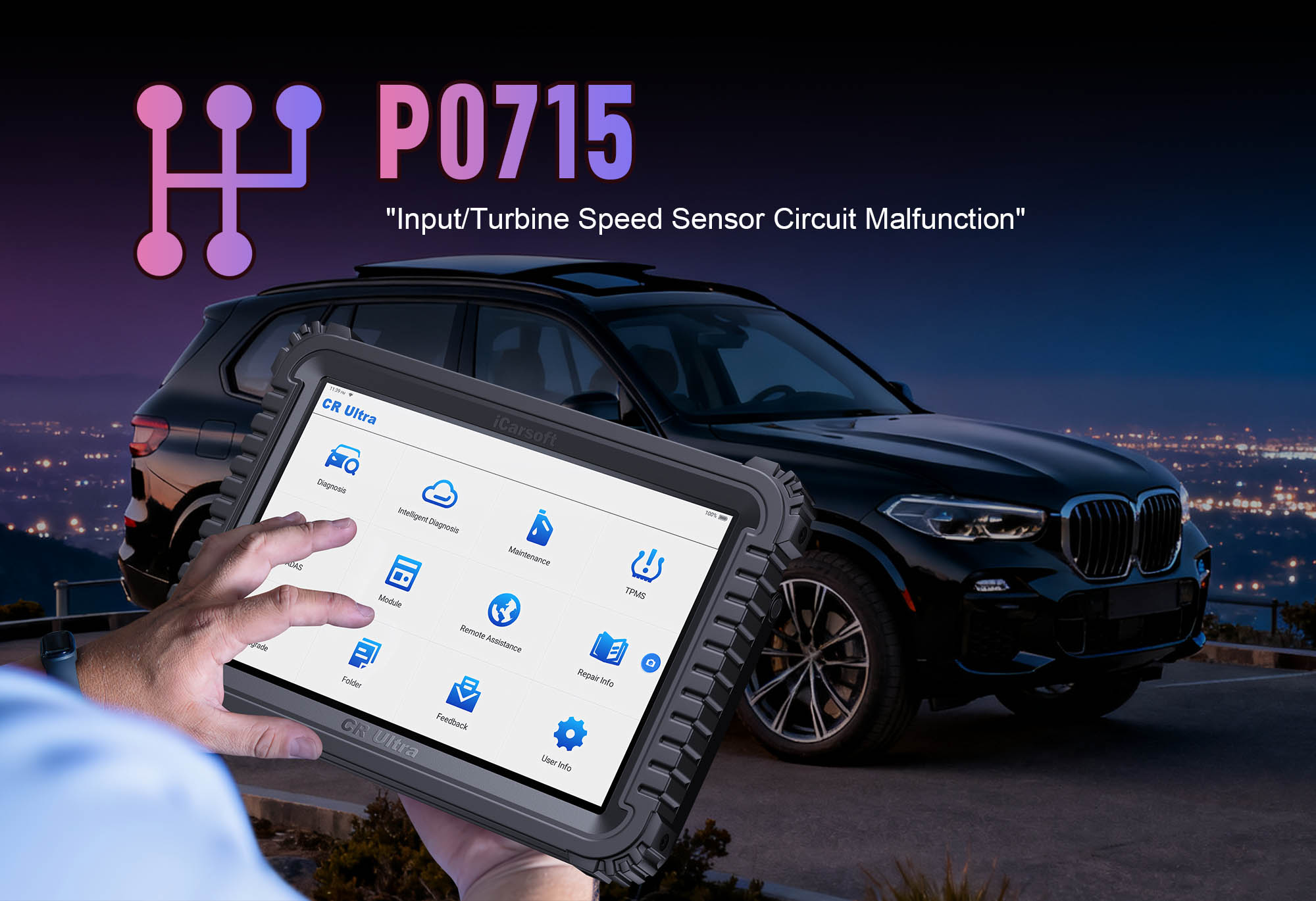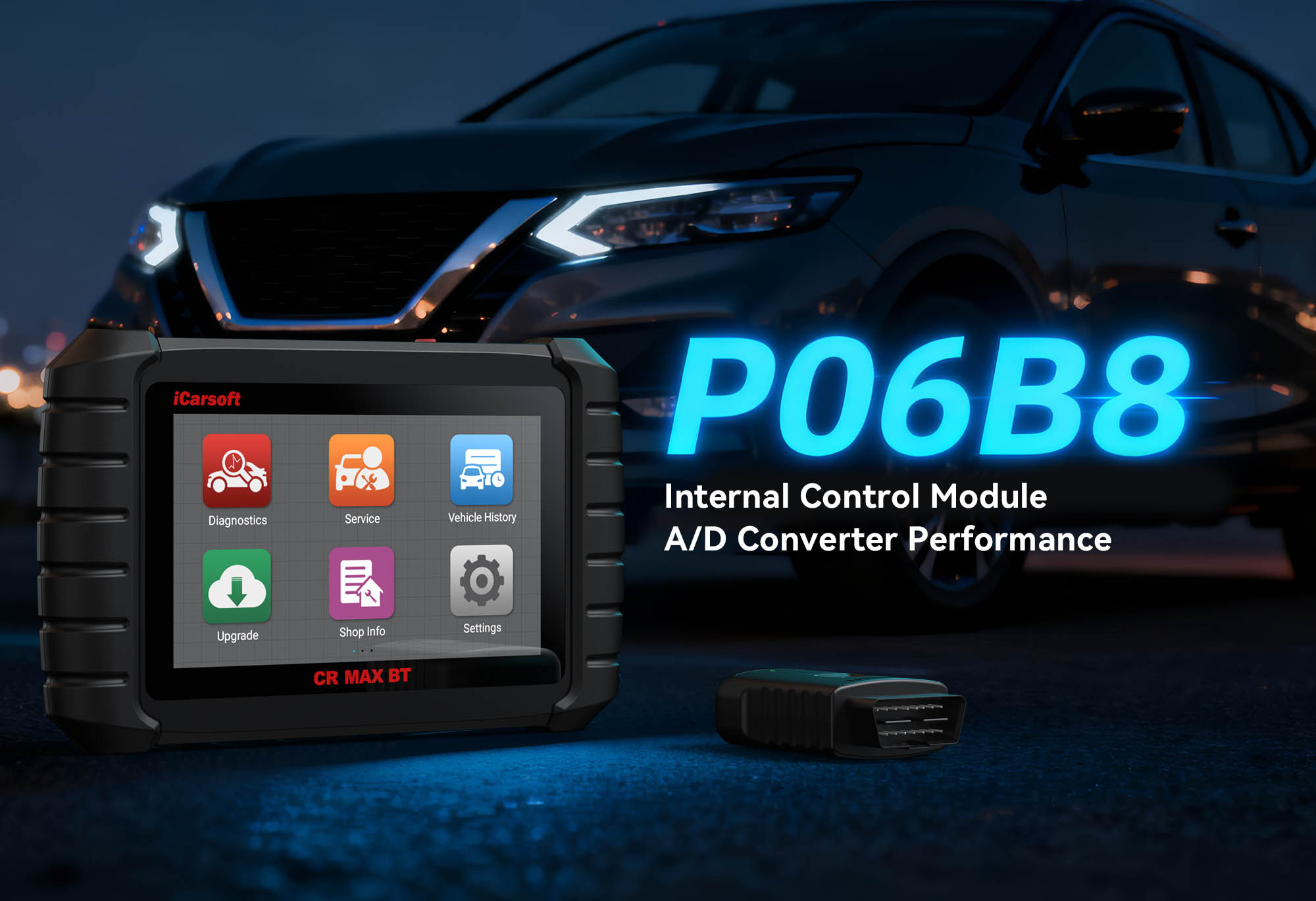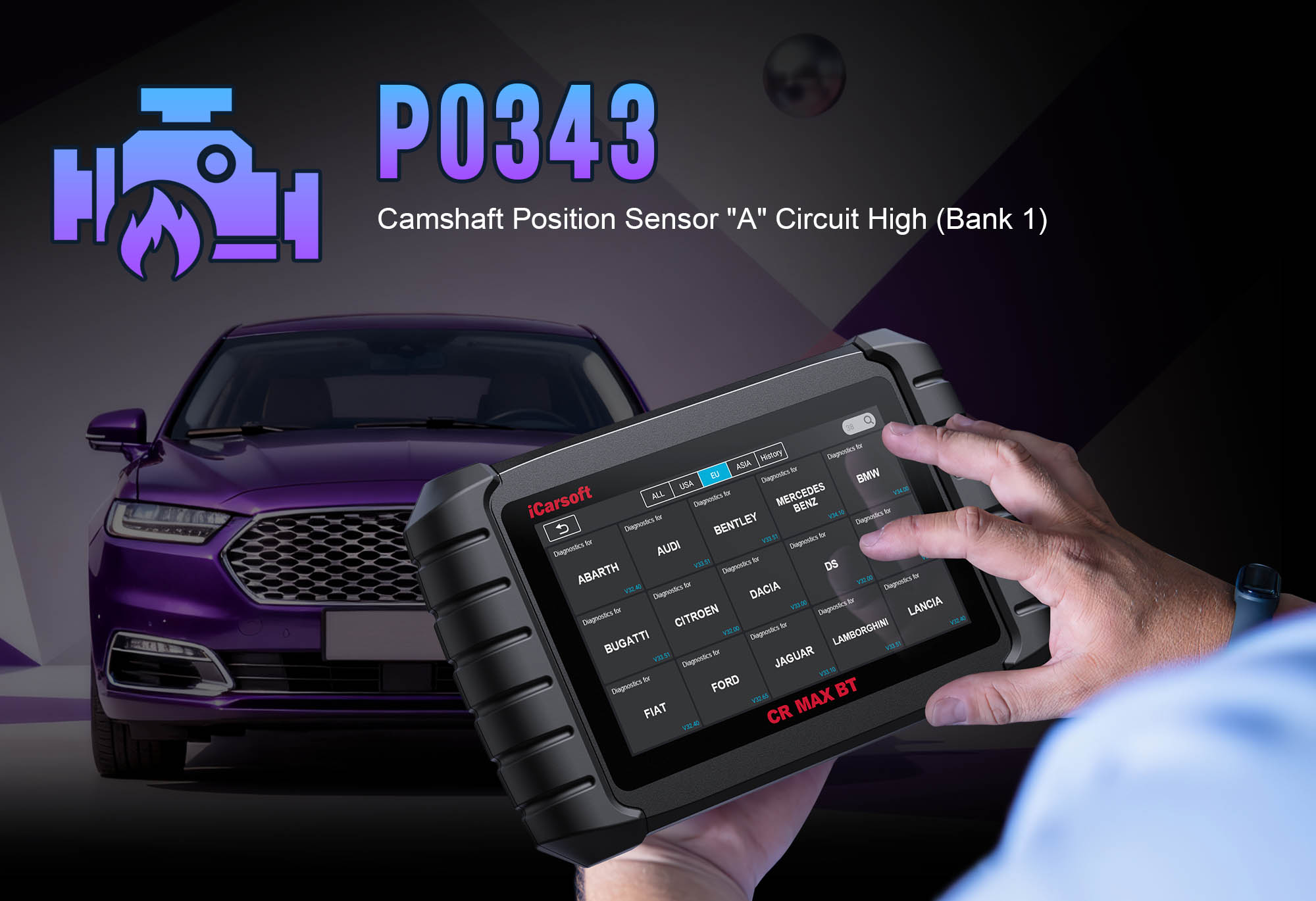P0715 Code: Diagnose & Clear Transmission Input Speed Sensor Circuit Malfunction with iCarsoft CR Ultra
If your check engine light illuminates and you notice erratic shifting, delayed gear changes, or even a complete loss of automatic transmission function, a diagnostic scan will likely return P0715. This OBD-II code stands for "Transmission Input Speed Sensor Circuit Malfunction," indicating the Engine Control Module (ECM) or Transmission Control Module (TCM) is not receiving valid signals from the input speed sensor—a critical component that monitors how fast the transmission’s input shaft is rotating.
The input speed sensor works alongside the output speed sensor to help the TCM determine the correct gear ratio. By comparing input shaft speed (linked to engine RPM) with output shaft speed (linked to vehicle speed), the TCM adjusts shift timing for smooth, efficient performance. A healthy input speed sensor sends a steady AC voltage or digital pulse signal (typically 0.5–12V) that increases with shaft speed. P0715 triggers when this signal is missing, erratic, or outside normal voltage ranges—disrupting the TCM’s ability to calculate gear shifts. Left unaddressed, it can lead to transmission overheating, premature wear, or costly damage to clutches and bands.
Basic scanners may only flag "input speed sensor fault" but can’t test signal quality or distinguish between sensor, wiring, or TCM issues. The iCarsoft CR Ultra, with its specialized transmission sensor testing, live signal waveform analysis, and component mapping, solves this. Let’s explore how to diagnose and resolve P0715 with precision.
Understanding P0715: Causes & Key Symptoms
A malfunctioning input speed sensor disrupts transmission shift logic, with symptoms that worsen during acceleration or load changes—these clues help identify whether the issue is electrical or mechanical.
Key Symptoms of P0715
-
Erratic Shifting: The transmission slips between gears, shifts too early/late, or jumps to neutral unexpectedly.
-
Delayed Gear Engagement: It takes 2–3 seconds (or longer) for the transmission to shift into Drive or Reverse from Park.
-
Loss of Overdrive: The transmission refuses to shift into high gear (overdrive), reducing fuel efficiency at highway speeds.
-
Transmission Warning Light: Many vehicles trigger a dedicated "Transmission" or "PRND" light alongside the check engine light.
-
Limp Mode Activation: The TCM may lock the transmission in 2nd or 3rd gear to prevent damage, limiting speed to 30–40 mph.
-
Stalling When Shifting: In severe cases, the engine stalls when shifting from Park to Drive, as the TCM fails to coordinate with the ECM.
Common Causes of P0715
|
Cause
|
Description
|
|
Faulty Input Speed Sensor
|
Internal coil or magnet failure prevents the sensor from generating a signal—the most common cause of P0715.
|
|
Wiring/Connector Issues
|
Corroded terminals, frayed wires, or loose plugs in the sensor circuit disrupt signal transmission to the TCM.
|
|
Damaged Tone Ring/Reluctor Wheel
|
The toothed metal ring (mounted on the input shaft) has cracked or missing teeth, causing irregular sensor signals.
|
|
Low Transmission Fluid
|
Insufficient fluid reduces pressure, preventing smooth input shaft rotation and skewing sensor readings.
|
|
TCM/ECM Malfunction
|
A faulty module fails to process the sensor signal correctly—rare but possible, especially with outdated software.
|
|
Mechanical Transmission Damage
|
Worn bearings or a damaged input shaft cause irregular rotation, mimicking an input speed sensor fault.
|
Why iCarsoft CR Ultra Excels at Diagnosing P0715
The CR Ultra outperforms basic tools with features tailored to transmission sensor diagnostics—critical for isolating sensor, circuit, or TCM-related causes of P0715:
Input Speed Sensor Signal Analysis
Captures real-time voltage waveforms and pulse patterns, identifying missing signals, weak pulses, or erratic frequency to distinguish sensor vs. wiring faults.
Sensor Resistance Testing
Measures the sensor’s internal resistance to detect coil burnout (open circuit) or short circuits—avoids unnecessary sensor replacement.
Live Data Correlation
Cross-references input speed data with engine RPM and output speed readings (e.g., "Input speed = 2x engine RPM in 1st gear" = normal).
3D Transmission Mapping
Displays high-res diagrams of the input speed sensor, tone ring, wiring path, and TCM for 200+ brands (e.g., "Honda Accord: Sensor = Top of Transmission Case").
Bi-Directional TCM Tests
Sends commands to the TCM to activate sensor monitoring, verifying if the module is the source of the P0715 fault.
Fluid Level & Quality Checks
Guides users to check transmission fluid level/condition (via dipstick or fill port) to rule out fluid-related triggers for P0715.
Step-by-Step: Diagnose P0715 with iCarsoft CR Ultra
-
Check Transmission Fluid First
1. Park on level ground, start the engine, and let it reach operating temperature (5–10 minutes).
2. Locate the transmission dipstick (use CR Ultra’s Component Location tool) or check the fill port (sealed transmissions).
3. For dipstick models: Check level (between "MIN" and "MAX") and color—healthy = bright red; brown/black = degraded (needs replacement).
4. For sealed models: Use CR Ultra’s Transmission Fluid Temperature (TFT) Readout (175–200°F = operating temp) then check level per specs.
-
Connect the CR Ultra & Confirm the Code
1. Plug the CR Ultra into the OBD-II port (use adaptors for older models) and power on the tool.
2. Select your vehicle via Auto VIN Scan (instantly pulls specs) or manual entry.
3. Navigate to Transmission > Fault Codes > Read Codes to confirm P0715. Tap Code Details for vehicle-specific insights (e.g., "Toyota Camry: Check Sensor Connector & Tone Ring").
-
Locate the Input Speed Sensor & Related Components
1. Go to Component Location > Transmission > Sensors > Input Speed Sensor.
2. Use the 3D diagram to identify:
- Input Speed Sensor: Typically on the transmission case, near the torque converter (2–3 pin connector).
- Tone Ring/Reluctor Wheel: Toothed metal ring on the input shaft (generates sensor signals).
- Wiring Harness: Path to the TCM (check for damage near exhaust or moving parts).
- TCM Location: On the transmission or under the dashboard (critical for circuit testing).
-
Analyze Live Input Speed Sensor Data
1. Start the engine, engage parking brake, and put the transmission in Drive.
2. Navigate to Transmission > Live Data > Speed Sensors and monitor:
- Input Speed Sensor (ISS) Reading: Matches engine RPM in Park/Neutral; increases with vehicle speed in Drive.
- ISS Voltage/Frequency: Normal = 0.5–12V (fluctuates with speed) or increasing digital pulses. P0715 = 0V, constant high voltage, or erratic spikes.
- Output Speed Sensor (OSS) Comparison: ISS and OSS should correlate (e.g., ISS = 2x OSS in 2nd gear).
-
Test the Input Speed Sensor & Circuit
1. Sensor Resistance Test: - Turn off the engine, disconnect the sensor connector.
- Use CR Ultra’s Multimeter Function: Normal = 500–1,500 ohms (magnetic); 1,000–3,000 ohms (Hall-effect). Infinite = burnout; <100 ohms = short.
2. Circuit Continuity & Short Test: - Measure resistance between sensor signal pin and TCM pin (normal = <5 ohms). Check for shorts to ground (normal = infinite resistance).
3. Connector Inspection: - Clean corroded terminals; check for bent pins or water intrusion.
-
Inspect the Tone Ring & Mechanical Components
1. Tone Ring Visual Check: - Locate via 3D map (may require sensor removal). Look for missing/bent teeth or debris (metal shavings).
2. Mechanical Rotation Test: - Have a helper turn the engine over (Park) while observing the tone ring—should rotate smoothly (no wobbling = no input shaft damage).
-
Rule Out TCM/ECM Issues
1. TCM Software Update: - Go to System > Update Manager to check for firmware updates (fixes P0715 false triggers).
2. TCM Signal Validation: - Use Bi-Directional TCM Test to send a simulated ISS signal. TCM recognition = sensor/circuit fault; no recognition = TCM issue.
-
Repair & Clear P0715
1. Fix the root cause:
- Faulty Sensor: Replace with OEM part (use Part Lookup).
- Wiring/Circuit: Splice frayed wires, repair shorts, or replace connectors.
- Damaged Tone Ring: Replace (may require professional transmission work).
- Fluid Issues: Drain and replace fluid/filter (follow Service Guide).
- TCM Fault: Update firmware or repair/replace the module.
2. Clear the code: Navigate to Transmission > Fault Codes > Clear Codes to delete P0715.
-
Validate the Repair
1. Recheck live data: ISS readings match engine RPM (Park) and correlate with OSS (Drive); voltage/frequency rises smoothly.
2. Test drive: Accelerate through all gears—no slipping, delayed shifts, or limp mode activation.
3. Post-drive scan: Use Transmission System Scan after 50+ miles to confirm P0715 doesn’t return.
Preventing P0715 Recurrence
Use the iCarsoft CR Ultra to maintain transmission sensor health and avoid future P0715 issues:
-
Fluid Maintenance: Set Service Reminder to replace transmission fluid every 60,000–100,000 miles (sooner for towing/stop-and-go driving).
-
Sensor Circuit Checks: Include input speed sensor wiring in annual electrical scans—clean connectors and test resistance to catch early faults.
-
Tone Ring Inspection: Use Transmission Health Log to note irregular sensor signals (early signs of tone ring wear).
-
Software Updates: Enable Update Alerts to install TCM/ECM updates that improve sensor signal processing.
Conclusion
P0715’s input speed sensor issue can turn driving into a frustrating (and costly) experience, but the iCarsoft CR Ultra eliminates guesswork with targeted signal analysis, circuit testing, and component mapping. Whether replacing a sensor, fixing wiring, or updating the TCM, this tool ensures you resolve the root cause—restoring smooth shifts, fuel efficiency, and transmission longevity.
With the CR Ultra, diagnosing "transmission input speed sensor faults" becomes a precise process, keeping your vehicle’s transmission operating at its best for miles to come.
FAQs About P0715 Code
Q: Can I drive with P0715?
A: Short distances are possible, but prolonged driving risks transmission overheating or damage. If limp mode activates (locked gears), limit driving and address P0715 within 1–2 weeks.
Q: How much does it cost to fix P0715?
A: $50–$150 for an OEM input speed sensor; $80–$200 for wiring/connector repairs; $150–$300 for tone ring replacement (plus labor). TCM repairs/additions cost $300–$800. The CR Ultra ($200–$300) saves by targeting the root cause.
Q: Will changing transmission fluid fix P0715?
A: Only if low/degraded fluid is skewing sensor readings. Use the CR Ultra to confirm—if the sensor or circuit is faulty, fluid replacement alone won’t resolve P0715.
Q: Can a bad TCM cause P0715?
A: Yes, but it’s rare. A faulty TCM may fail to process the input speed sensor signal correctly. Use the CR Ultra’s bi-directional tests to confirm if the TCM is the issue before replacement.





